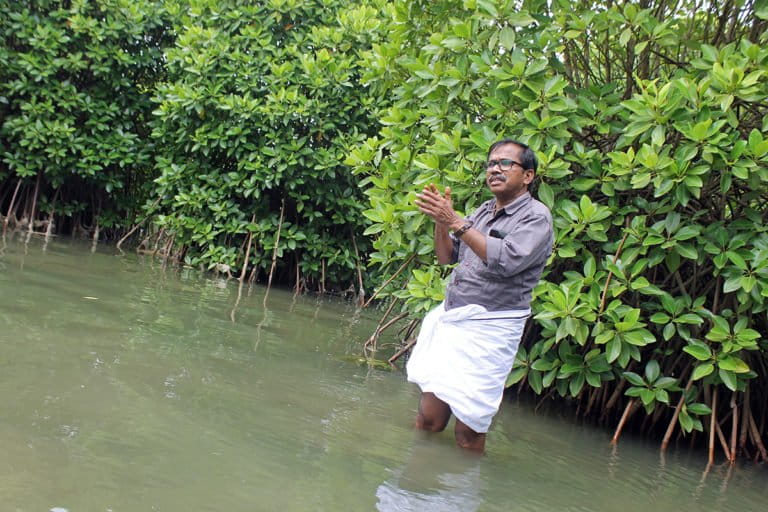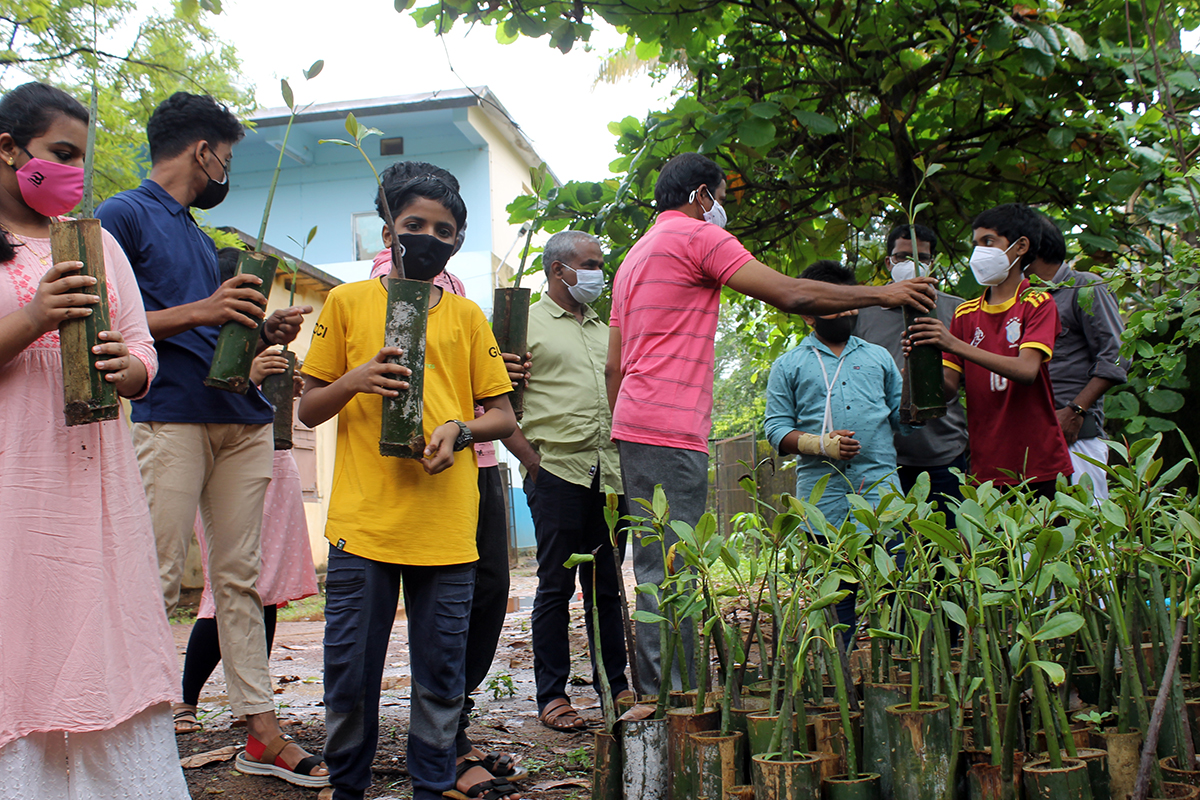- The legacy of the late Kallen Pokkudan, a Dalit farmworker and intrepid mangrove conservationist in Kerala, is being carried forward by his children.
- His children have pledged to realise Pokkudan’s vision of shielding Kerala’s hazard-prone coast by erecting mangrove protection walls all along the coast in six years.
- They have begun by reviving a mangrove promotion trust formed by him in 2013 to impart mangrove conservation literacy.
- The trust has started preparing mangrove nurseries in collaboration with schools, youth clubs and voluntary organisations to generate enough seedlings to plant in areas that witness sea erosion.
Born into a marginalised family in 1937 in Kerala, his umbilical cord looked almost like a bloated seed of a common mangrove tree. So, his parents who worked as farm labourers named him Pokkudan, which in the local language, refers to infants with such umbilical cords. The man, who was unable to complete elementary school education due to poverty and caste-based discrimination, died on September 27, 2015, leaving behind a rich legacy of protecting 22 species of mangroves from local extinction.
Better known as Kallen Pokkudan, the Dalit from Kannur district became a celebrated guardian angel of Kerala’s mangrove forests through dedicated interventions over the years. Pokkudan travelled across Kerala’s coast telling the local communities, especially fish workers, that only mangroves could protect coastal assets during hazards such as cyclones. On his travels, he collected seeds of 22 species of mangroves. There were only a few takers in those years for his argument that mangroves are one of the vital long-term solutions to sea erosion and storms, which turn coastal communities into climate refugees.
To prove his point, Pokkudan had created mangrove walls at Choodat beach in Kannur and Arattupuzha in Alappuzha and prevented sea erosion-related issues that concerned the respective local fishing communities.

Now, climate change and rapid, unscientific development of mega infrastructure projects have crippled everyday life on the 590-km long Kerala coastline; sea-erosion and sea accretion are worsening the situation. Experts have warned that coastal areas in the state will witness an increasing number of sea surges in the coming years, primarily due to rising sea surface temperatures. Experts advocating for nature-based solutions involving the active participation of coastal communities are looking to answers such as those spotlighted by Pokkudan, who consistently argued that erecting granite seawalls would turn counter-productive. Restoring coastal vegetation, mainly mangrove forestation, is the need of the hour, they say.
“It was 1989; my father started planting mangroves seedlings along mud-bunds which protect the traditional shrimp fields in the brackish water wetlands of Kannur where wet paddy and fish are cultivated. He was 52 then. Soon he started mounting public opinion against land reclamation, garbage dumps and deforestation that threatened coastal forest ecosystems. Then based on the traditional knowledge he gained and practical expertise from the local fisher community, he concluded that mangroves are the best available deterrent against sea erosion,” said Anandan Paithalen, elder son of Pokkudan, a schoolteacher by profession.

Anandan is now on a unique mission with his five siblings. They revived the defunct Kallen Pokkudan Mangrove Trust in recent months, formed by their father in 2013 to impart mangrove conservation literacy to society. With the help of Kerala government’s social forestry and education departments and environmentalists, the trust has started preparing mangrove nurseries in schools, youth clubs, and voluntary organisations in ten coastal districts to generate enough seedlings to plant in areas that witness sea erosion. The Kerala coast would get a mangrove protection wall in another six years as per the ongoing project.
“My father had incurred financial debt by devoting himself to promote the mangroves. After his death, the immediate priority of the family was to clear the debts. Now we are reviving the trust using our resources and his legacy through conservation activities,” said Anandan Paithalen’s sister Pushapalatha.
“They can buffer erosion, enhance bio-biodiversity, prevent high tide incursion, and even reduce the impact of future tsunamis. So, we have high hopes for the initiative started by Pokkudan’s family. The appreciative aspect is that they collect the seeds and make them available free of cost at the respective nurseries to local communities. The government departments and environmentalists can only meet expenses of the upbringing at the nursery,” said Jaffer Palott, noted environmentalist.
According to P Sujanapal, a scientist with Kerala Forest Research Institute, Kerala’s mangrove cover has severely disintegrated in the last four decades with their spread declining from 700 sq km to 24 sq km in that period. Of the remaining wetlands, Kannur has 45 percent of the total mangroves, largely thanks to Pokkudan. Now the effort is to increase the mangrove cover manifolds mainly in the coastal region.
Like Pokkudan, his children also live in close contact with the wetlands of Kannur and collect, preserve, and plant the seeds, primarily of the “mad mangrove” tree – the long-fruited, stilted mangrove known as Rhizophora mucronata.
They are also promoting some other rare species of mangroves. In total, 22 varieties of mangrove trees welcome you to Pokkudan’s village Pazhyanagadi in Kannur district, including Clerodendrum inerme, Premna serratifolia, Acanthus ilicifolius and Derris scandens. The surroundings of Pokkudan’s ancestral home have now turned into a massive mangrove nursery.

Interestingly, what had led to Pokkudan’s passion for mangroves was political disillusionment. Pokkudan had spent a significant share of his life organising and strengthening the labourers’ union of the Communist Party of India (Marxist). He started noticing how monsoon storms were drenching little school-going children while they walked to the school through narrow mud paths in his hometown. During heavy monsoon days, the lashing winds would take their umbrellas away. The high-energy storm waves would destroy embankments around the paddy cultivating areas.
Over the years, the mangrove wetlands in his hometown had turned into garbage dumps for neighbouring towns. Such a situation had severely affected the ecological functions of the wetlands; it had impacted their nutrient cycling, flood control function, groundwater recharging, salt dissipation, absorption and dilution of pollutants, and the creation of microclimatic niches that support different forms of life. The mangroves always remained a rich medicine, food, and fuel source for the marginalised community (Pulayan) Pokkudan belonged to. “The fish, the birds, and the people all depend on the mangroves,” says Anandan. He said his father called the trees “the security guards of the earth” and was convinced that floods in coastal regions would not kill so many if there were mangroves.
According to Pokkudan’s younger son Sreejith, collecting the seeds of the mangrove trees is strenuous work. Besides, the swamps where mangroves grow often remain choked with waste. “Our father aimed to construct a mangrove wall in the coast, and we will fulfill it,” said Pushpalatha, one of Pokkudan’s children. “In the past, our father had led a one-person movement for mangroves. Now, his family is in the process of evolving it as a mass movement with the involvement of students, fish workers, and farmers,” she added.

“So far, the government has dumped granite boulders mined from the Western Ghats on the coast. The construction of granite boulder walls that began in the 1960s turned into a wasteful process with huge expenditure from the public exchequer. The ideal option is creating a green belt comprising the finest varieties of mangroves in the coastal region. It must be a unique wall that can grow organically and ensure a sustainable livelihood option for coastal communities,” says Anandan.
“Numerous mangrove restoration projects were initiated after the 2004 tsunami. Mangroves can rapidly diminish the height of wind and the swell of waves. Even during relatively large storm surges, the leaves and branches of the forest canopy will help reduce wave energy providing the trees are tall enough,” points out coastal zone expert Max Martin.
According to aquatic biologist A. Bijukumar, restoring the coastal mangrove ecosystem is a challenging and gradual process that needs to be scientifically robust. “The effort is to plant mangroves in areas where they were not in existence for long, especially the mudflats. In such areas, saplings that can withstand soil erosion and wave action must be preferred. Low oxygen availability due to constant moisture is an issue in mudflats, and that may cause high seedling mortality and stunted growth. So the choice of local good quality seed is important,” he said.
“Some mangrove species tolerate greater saltwater flooding than others. They must be preferred. To create a multi-species community we need to combine species that complement one another. Involving the local communities, especially fish workers, in the process is supreme. Local communities know much about successful mangrove management, and their involvement is key to long-term success in restoration, management, and benefit flows,” he said.
Inspired by Pokkudan, 55-year-old fish worker T P Murukesan of Vypeen in Kochi started his mangrove nursery and plantation initiative ten years ago to prevent sea erosion and flooding on the coast. In collaboration with Pokkudan’s family, Murukesan is engaged in plantation drives in coastal villages of Cherai, Njarackal, North Mulavukad, Nayarambalam, Vallarpadam, Mangalavanam, and Chellanam with the forest department. The mangroves he planted grow lush, providing animals and birds with a safe environment.
As per the initial plan, seedlings prepared in the nurseries would be taken to the coast for planting by October end coinciding with the opening of educational institutions in Kerala after COVID-19 lockdown. The trust feels that the involvement of school and college students is critical in promoting mangroves. The same kind of activities would be undertaken by the trust every year. “We are also determined about the involvement of the fisher community,” says Anandan.
Banner image: A mangrove forest grown by Kallen Pokkudan at Pazhayangadi in Kannur protects its backwater region from flooding. Photo by J U Bhavapriya.
